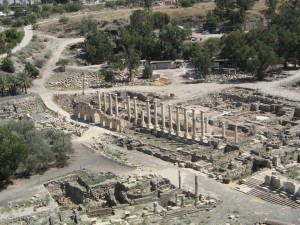My recent emergence from the shadowy timber post-holes and decayed Roman villas that constitute England’s archaeological landscape and my plunge back into the comforting materiality of Late Roman cities in Israel has set me thinking about the reuse and reconstruction of Roman remains in areas such as Palestine. Although Roman culture quickly disintegrated in Britain and other parts of Western Europe, the political continuity of the Roman into the Byzantine Empire in the Near East ensured the cultural relevance of the Roman legacy in Palestine well into the 6th and 7th centuries. Yet artistic and architectural styles did not remain unchanged. How did the inheritors of the Roman legacy in the East choose to reuse, reconstruct, and reinterpret the Roman remains they took care to preserve along the skylines of their respective cities?

Bet She’an, a Roman Decapolis city south of the Sea of Galilee which expanded and grew during the Late Roman period (4th to 6th centuries C.E.)
An interesting case is Bet She’an, a site the Omrit crew visited last month. The site, with its hippodrome-cum-odeon, the monumental scenae frons of its Roman theater, and its sprawling bath complexes, was an impressive statement of Roman power in the recently Hellenized Near East. By the Byzantine period, however, the fabric of the city had begun to change due to the cultural shifts associated with the conversion to Christianity and the collapse of the Empire in the West. Traditionally, the shifts witnessed in Eastern Roman cities during the Late Roman period have been viewed with implicit value judgment, and Byzantine construction is often termed “inferior” to that of the Roman period. At Bet She’an, Late Roman additions to the city often prioritized economic functionality rather than aesthetic attractiveness as determined by the traditional Greco-Roman perspective: new streets meandered away from their straight Roman predecessors, basalt replaced limestone as the preferred building material, Byzantine shops filled in the intercolumniations of Roman porticos.
Yet the Late Roman period was also a time of population and economic expansion, and although the city remained proud of its Roman architectural heritage, it also worked to fit the old values into the very different visual culture of Late Antiquity. In the 6th century, a Late Roman basilica replaced a former Roman colonnade and decorative pool that ran along one of the main east-west streets of the city. Rather than destroying the colonnade, however, the inhabitants of the city used the elegant Roman portico to support a gabled roof. On the other side, a mirroring arcade (of ‘negligent construction,’ according to the excavators) was built with spolia of various sizes and shapes collected from former Roman buildings across the site. In a Greek metric inscription on the building, the personified arcade thanks his benefactor, who, it claims, had prevented the Roman portico from collapse. The Late Roman period dramatically changed the aesthetic of this portico. Yet its reuse nevertheless signifies a continuing allegiance to the Roman tradition—an allegiance indicated by its very reconfiguration of the Roman past according to new cultural values.
In the most recent stages of excavation at Omrit, we have explored the town that grew up around the temple in the Late Roman period. Although excavation at Omrit has not yet found the astonishingly well-preserved remains from the period that are seen at Bet She’an, many of the same trends reappear: the tendency to incorporate Roman spolia into Late Roman basalt walls, the division of Roman porticos into small shops, the localization of ceramics and other material finds. As we continue to excavate at Omrit, we should take care to avoid the value judgments that have been imposed on other sites in the Near East. Even the fact that settlement at Omrit—a settlement that may have grown up as a direct result of the pagan temple–flourished in the Late Roman settlement demonstrates a continued adherence to Roman legacy despite the religious and cultural changes of the 4th and 5th centuries. As excavation continues in future years and no doubt will uncover more Late Roman material, it will provide a fertile ground for the study of the ways in which a post-Roman settlement balanced an esteemed architectural heritage with new artistic values that rejected some of the precepts upon which the Roman visual tradition had been established. Perhaps, as at Bet She’an, the changes seen at Omrit in the Late Roman period did not reject or degrade the Roman tradition, but rather revitalized it through reinterpretation.
In the 21st century, we often think of ‘reconstruction’ in a scientific, exacting sense. Many sites attempt to ‘reconstruct’ their antique past by providing visitors with hypothetical drawings or sculpture that supposedly depict what ancient life ‘really looked like.’ Excavators at Umm al-Qanatir, the site of a Late Roman Jewish synagogue in the Golan, has even used computer programs to locate the original placement of wall tumble, with the ultimate goal of complete reconstruction of the building. In many ways, our ‘scientific’ reconstruction of archaeological sites betrays the same goals as the Late Roman basilica at Bet She’an. Despite our careful measurements and delineation of loci, as we work from the tangled mess that represents the reality of complex stratigraphy, of the ever-feared contamination, we realize that even this reconstruction necessitates interpretation, imagination. Yet this act of imaginative reconstruction–of recreating the past for a new generation–also revitalizes. No less than the Late Romans in Bet She’an and at Omrit, we archaeologists meet the Roman tradition halfway, constantly breathing into its remains the inspiration of contemporary values, constantly searching for its legacy in the aesthetic milieu of the 21st century, constantly reaffirming its continuing relevance by its comparison with our own world.
